The first Thunderbolt cables and peripherals debuted last week, so
we're finally seeing hand-on reports and product views. Although
Thunderbolt has great potential, finding products that can truly take
advantage of its incredible bandwidth is another story.
General Apple and Mac desktop news is covered in Mac News Review. iPad, iPod, iPhone, and
Apple TV news is covered in iOS News
Review. All prices are in US dollars unless otherwise noted.
Thunderbolt News
News & Opinion
Tech Trends
Thunderbolt News
Thunderbolt Cables Get Warm in Use
Hardmac's Lionel says he is not surprised that Apple's new
Thunderbolt cable, which contains some fairly sophisticated inline
electronics (see last week's 'Book Review),
heats up in use, and he would be curious to know how much power is
being consumed by these cables. He adds that the cable is intelligent
enough to power down its electronics when only one end is
connected.
Link: Thunderbolt Cables
Get Warm
Thunderbolt Target Disk Mode Slower than FireWire
800
OWC blogger Michael says that since Apple released
Thunderbolt-equipped Macs, questions have been pouring in on how
quickly we'll be able to see benefits of blazing external speeds, but
no Thunderbolt cables were even available until last week when Apple
began offering the Promise Technology Pegasus R4 & R6 RAID
solutions.
The OWC folks have now gotten their hands on a few of these cables
and are able to start answering the questions they've received in
detail, the first topic tackled being Thunderbolt Target Disk Mode,
with test results a disappointment, being substantially slower than
performance in FireWire Target Disk Mode using FireWire 800.
Link: Thunderbolt
via Target Disk Mode
Enormous Disappointment with Thunderbolt Target
Disk Mode
Hardmac's Lionel says that having two compatible Macs, a 2011
MacBook Pro and a 2011 iMac, but not a RAID box, Hardmac decided to
test Thunderbolt using a method practiced over the years with FireWire
- Target Mode. With Thunderbolt he had anticipated that using a Crucial
M4 SSD, data flows close to what's possible using it as an internal
disk would be realized, but the experience fell far short, reaching a
maximum at less than 50 MB/s in writing and less than 74 MB/s in
reading - much less than the data flow of this disc. He concludes, "The
only hope is the wish that it is a residual bug of Thunderbolt or that
something skewed our tests (however we repeated them on several
occasions)."
Publisher's note: Although not mentioned in this article, Hardmac
benchmarked the
Crucial M4 SSD earlier this year in a 2011 MacBook Pro and reported
write speeds of 280 MBps (almost six times as fast as Target Disk Mode
results) and read speeds of 416 MBps (over five times as fast).
dk
Link: Enormous
Disappointment with Thunderbolt Target Disk Mode
Video: How to Enable Thunderbolt Target Disk
Mode
Macworld's Mauricio Grijalva has posted a tutorial video on how to
use Thunderbolt Target Disk Mode to mount a second Mac as an external
hard drive using the Thunderbolt port on the current iMac and MacBook
Pro and Apple's new $49 Thunderbolt cable.
Link: How to Enable
Target Disk Mode via Thunderbolt
News & Opinion
All Mini DisplayPort-to-HDMI Cables Recalled
SmartHouse's David Richards reports that Apple and Android tablet
makers who use Mini DisplayPort-to-HDMI cables are facing a major
problem after a HDMI Organization source said that the mini connection
does not comply with HDMI spec. Affected are Apple with their MacBook
notebooks, Motorola with their Xoom tablet, ViewSonic, Acer, Cisco and
RIM's Blackberry.
Richards says that according to the HDMI Organization, tens of
thousands of Mini DisplayPort to HDMI cables are to be recalled because
the cables do not comply, and a lot of companies that are using Mini
DisplayPort HDMI connectivity have not sought deauthorization or paid a
license fee, which they have to do if they want to use the HDMI name on
their devices.
Publisher's note: Recent developments indicate that the problem is
that the HDMI specification requires HDMI on both ends of the cable, so
anything type of HDMI conversion cable falls outside the specification.
Because of this, the HDMI Organization is working to have all such
cables recalled and taken off the market. dk
Link: HDMI Mini Port
Problem Set to Hit Apple's Notebooks and Android Tablet Makers
Revised MacBook Air Rumored to Use 400 Mbps 'Toggle
DDR 2.0' Flash Memory
The Japanese Apple-focused blogsite Macotakara says that according
to an unnamed Asian electronics component company person, Apple appears
to be fixing to adopt the 400 Mbps interface "Toggle DDR 2.0" NAND
flash memory, a 19-nanometer process, for new MacBook Air. Since its
major revision in October 2010, the Air has used only NAND drives for
data storage.
Macotakara speculates that the current SSD device Blade X-gale,
supporting SATA 2.6, that is used in the current MacBook Air models,
will be dropped, and new 19nm flash memory will be packaged into
smaller chip and will be soldered directly to the motherboard.
The Open NAND Flash Interface Working Group, NAND technology's
standardization organization, has already released ONFi 3.0, the report
says. That standard supports 400 Mbps specifications like Toggle DDR
2.0, but the top 70% of NAND processing companies, including Samsung
(36.9%) and Toshiba (35.1%)m as of the first quarter of 2011 had not
joined on this ONFi.
Toggle DDR 2.0 is a standardized procedure defined by JEDEC (Global
Standards for the Microelectronics Industry), and Macotakara says JEDEC
seems to have Apple's support.
If this rumor is accurate, it's already a fait-accompli.
Apple is believed to have already stockpiled 400,000 next-generation
MacBook Airs powered by Intel's state-of-the-art Sandy Bridge Core "i"
processors, and supporting the new high-speed Thunderbolt I/O port last
month in preparation for consumer launch as soon as OS X 10.7 Lion
is released, which is widely expected to be on July 14.
Link: 新
型MacBook
Airに、19nmプロセス製造による「Toggle
DDR2.0」規格NANDフラッシュメモリを採用?
(English
translation by Google Translate)
Soldering SSDs to the Motherboard Is a Really Bad
Idea
ZDNet's Jason D. O'Grady says there are two things that disturb him
about the upcoming third-generation MacBook Air: it could ship still
without a backlit keyboard, and it's rumored that the Air's SSD may be
soldered onto the motherboard along with its processor and system
RAM.
On the SSD issue, Jason is referencing a report from the Japanese
Apple-centric blogsite Macotakara (above) that says Apple appears to be
ready to adopt "Toggle DDR 2.0" NAND flash memory for the new MacBook
Air, replacing the Blade X-gale SATA 2.6 SSD used in the current
MacBook Air, packaged in a smaller chip and soldered on, which would
eliminate enduser upgrades.
O'Grady acknowledges that the new Toggle DDR NAND Flash would be
faster than the current crop of SSDs, but he's not a fan of planned
obsolescence and doesn't like buying a computer that has a fixed amount
of RAM or storage, since it seriously limits upgrade options later
on.
He notes that Larry O'Connor, Founder & CEO of Other World
Computing, has also called the rumored move "disappointing," but
observes that change like this would be right in line with Apple's
evident ongoing trend to promote buy and replace cycles with
non-expandable/serviceable (at the enduser level) products, getting
users to buy computers that are only useful for a year or two.
Your editor agrees. The soldered-on, non-upgradable RAM was already
the biggest inhibiting factor inclining me away from a MacBook Air as
my next system upgrade and toward the 13" MacBook Pro, and soldered-in
storage would be the deal-breaker. I still have two 11-year-old Apple
laptops in active service, and I'm little interested in machines that
will be obsoleted in a couple of years.
Link: Rumor: Apple
Soldering MacBook Air SSD to Motherboard (and Why It's a Bad
Idea)
The Only Reason You Shouldn't Buy a MacBook
Air
Forbes' Brian Caulfield observes that the word compromise is
never part of Apple's lexicon in its narrative about its products, and
that's a shame, says Caulfield, because by his lights the MacBook Air
is a study in the power of compromise - less powerful than Apple's
other notebooks, equipped with fewer features, and in his estimation
"uglier" than many of Apple's other offerings.
However, Caulfield contends that the compromises add up to a better
notebook - lighter, quicker to boot, affordable at the $999 entry-level
price - so unless you're a serious gamer or professional power-user
editing video or somesuch, it's just more practical.
However, he advises that now is not the time to run out and buy a
MacBook Air, as new models are just around the corner.
Link: The Only Reason
You Shouldn't Buy a MacBook Air
Former Microsoft Employee Buys a MacBook Air
Blogger Jian Shuo Wang says he's bought himself a 13'' MacBook Air notebook,
saying he's had fun with his iPhone, leading to a desire to explore
other Apple products. He'd initially considered an iPad 2, but on sober second thought
figured he'd use a laptop more, since he prefers a physical
keyboard.
Wang says being an Apple user is a strange space for him to be in,
having been a Microsoft employee for seven years, where it's not
politically correct to use Apple products, or Linux products. However,
he says he's a big fan of PHP, Linux, cheap scalable servers, enjoys
Apple, and for search prefers Google to Microsoft's Bing, and that not
working for Microsoft gives him freedom to try different things, and
hopefully cultivate a more balanced perspective, leading to other
philosophical musings.
Link: I Bought Myself a
MacBook Air
Products & Services
NextComputing Radius EX-B Mobile Workstation PC:
Neither a Laptop nor Tablet
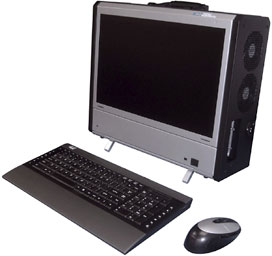 PR: Nashua, NH based NextComputing has announced the
latest addition to its Radius series of mobile (but not laptop)
computers, the Radius EX-B. Based on NextComputing's Radius EX
all-in-one portable workstation, the Radius EX-B is NextComputing's
first portable system to feature an integrated battery for total
mobility.
PR: Nashua, NH based NextComputing has announced the
latest addition to its Radius series of mobile (but not laptop)
computers, the Radius EX-B. Based on NextComputing's Radius EX
all-in-one portable workstation, the Radius EX-B is NextComputing's
first portable system to feature an integrated battery for total
mobility.
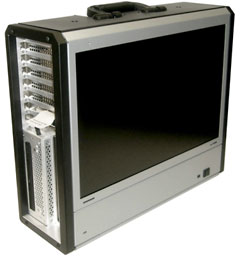 Users in industries like military intelligence, oil and gas
exploration, digital video production, and network testing need
high-performance hardware for their demanding applications. Features
like full-powered CPUs, high-end 3D graphics, fast RAID storage, and
PCI expansion slots are often required for these mission-critical
applications. But when trying to run these applications in the field,
these users are often forced to choose between large, non-mobile
systems like a tower or rack-mount server that gives them the
performance they require, or scale their application down to run on a
laptop for mobility.
Users in industries like military intelligence, oil and gas
exploration, digital video production, and network testing need
high-performance hardware for their demanding applications. Features
like full-powered CPUs, high-end 3D graphics, fast RAID storage, and
PCI expansion slots are often required for these mission-critical
applications. But when trying to run these applications in the field,
these users are often forced to choose between large, non-mobile
systems like a tower or rack-mount server that gives them the
performance they require, or scale their application down to run on a
laptop for mobility.
NextComputing solves this problem with the Radius EX-B. Like all
NextComputing portables, the briefcase-like Radius EX-B is designed to
offer true workstation and server performance in a compact, all-in-one
package that is easy to transport and set up. But unlike other
NextComputing portables, the Radius EX-B can run completely untethered,
without being plugged into a power source.
This offers a number of advantages, including:
- The ability to transport the system from room to room within a
facility without powering down
- Keeping the unit running continuously in the event of a power
failure
- Running the system in a remote environment where power is
intermittent or unreliable such as military base station or
trailer
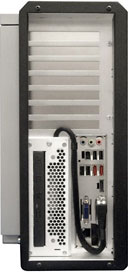 The Radius EX-B features:
The Radius EX-B features:
- 320W power supply with removable Lithium-ion battery pack, able to
power the system at full-load for 2 hours, longer when idle
- Built-in 17-inch widescreen, high-resolution (1920 x 1200) LCD
monitor
- Workstation-class 2nd Generation Intel Core i7 Quad-Core processor
or Intel Xeon E3-1200 series processor
- Up to 32 GB DDR3 memory (using 8 GB DIMMs)
- 4 full-length, full-height PCI Express and PCI expansion slots
- Integrated Intel HD Graphics or discrete professional graphics
solutions from Nvidia and AMD
- Up to 6 TB of fixed or removable storage with multiple RAID
options
- Optional 2nd and 3rd Clip-On, 1" thin 17' widescreen (1920 x 1200)
monitors, able to run off of system battery power
- Compact, all-in-one chassis with comfortable leather handle and
convenient carrying case
- Optional rolling case with telescoping handle or rugged
MIL-STD-810F certified hard case
"Customers across many markets depend on our portable workstations
and servers, because they are the most flexible and capable mobile
systems available, while also being the smallest and lightest," says
Bob Labadini, President/CTO of NextComputing. "Because they are
powerful, enterprise-class computers, these systems have traditionally
required external power, usually from a wall outlet or a DC source like
a vehicle. The Radius EX-B changes all this. Our customers now have a
fully mobile, all-in-one workstation, able to run their applications
from literally anywhere."
The Radius EX-B is available now from NextComputing and its
authorized resellers. Call +1-603-886-3874 or email
Sales(at)NextComputing(dot)com.
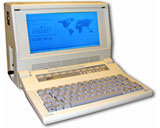
Zenith Z-171
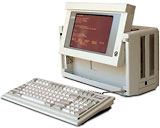
Compaq Portable III
Publisher's note: NextComputing has no relationship to NeXT Computer, the company Steve Jobs founded in 1985 after
leaving Apple, and the Radius product name appears to have no
relationship to the line of monitors, accelerators, and Macintosh clones sold under the Radius brand in
the 1980s and 1990s. However, this is an interesting solution to
portable computing issues, providing iMac-like integration, Mac
Pro-like expandability, and, at 17 to 22 lb., Mac Portable-like portability. It's
an interesting approach. Old timers may recall the days when "lunchbox"
portables, such as the Compaq Portable III (1987)
and the even earlier Zenith
Z-171 (1985), provided desktop power in a transportable, AC-powered
computer. dk
Link:
Radius EX-B
Intel Offering Subsidies to Encourage Vendors to
Launch Ultrabooks
DigiTimes' Monica Chen and Joseph Tsai report that Intel has started
planning a new marketing strategy for its Ultrabook concept and is
investing heavily in the related budget and resources, hoping to
attract first-tier notebook vendors into developing Ultrabooks,
according to the site's usual unnamed industry sources.
Chen and Tsai note that Intel's Consumer Ultra Low Voltage-based
(CULV-based) ultra-thin notebooks in 2009 failed, and that the notebook
market has been severely impacted by tablet PCs, mostly Apple's iPad,
so consequently most notebook vendors are taking a cautious approach to
embracing Intel's MacBook Air-like Ultrabook concept, leading to
Intel's heavy investment in hope of enticing these vendors to launch
Ultrabook products with a goal of having 40% of global consumer
notebooks sold using its Ultrabook concept at the end of 2012.
One example will be Asustek's first Ultrabook concept-based
notebook, the UX21, coming in September, but the article says the
Ultrabook CPUs' relatively high prices are still an inhibiting factor
affecting downstream vendors' willingness to adopt due to concern as to
whether Ultrabook product prices can reach as low as the US$1,000 price
point claimed by Intel, and that while several vendors have Ultrabook
prototypes in the testing stage, most are still conservative about
opening projects for production and waiting to see how Asustek fares
with its UX21 before committing.
Tech-wise Intel has recently added four dual-core CPUs to its
Ultrabook product line, and the report says it's set to launch a
single-core Celeron 787 CPU in September and Celeron 857 in the fourth
quarter to replace Celeron 847.
Link: Intel Offering
Subsidies to Encourage Downstream Vendors Launching Ultrabooks
(subscription required)
Bargain 'Books
For deals on current and discontinued 'Books, see our 13" MacBook and MacBook Pro,
MacBook Air, 13" MacBook Pro, 15" MacBook Pro, 17" MacBook Pro, 12" PowerBook G4, 15" PowerBook G4, 17" PowerBook G4, titanium PowerBook G4,
iBook G4, PowerBook G3, and iBook G3 deals.
We also track iPad,
iPhone, iPod touch, iPod classic, iPod nano, and iPod shuffle deals.

 PR: Nashua, NH based NextComputing has announced the
latest addition to its Radius series of mobile (but not laptop)
computers, the Radius EX-B. Based on NextComputing's Radius EX
all-in-one portable workstation, the Radius EX-B is NextComputing's
first portable system to feature an integrated battery for total
mobility.
PR: Nashua, NH based NextComputing has announced the
latest addition to its Radius series of mobile (but not laptop)
computers, the Radius EX-B. Based on NextComputing's Radius EX
all-in-one portable workstation, the Radius EX-B is NextComputing's
first portable system to feature an integrated battery for total
mobility. Users in industries like military intelligence, oil and gas
exploration, digital video production, and network testing need
high-performance hardware for their demanding applications. Features
like full-powered CPUs, high-end 3D graphics, fast RAID storage, and
PCI expansion slots are often required for these mission-critical
applications. But when trying to run these applications in the field,
these users are often forced to choose between large, non-mobile
systems like a tower or rack-mount server that gives them the
performance they require, or scale their application down to run on a
laptop for mobility.
Users in industries like military intelligence, oil and gas
exploration, digital video production, and network testing need
high-performance hardware for their demanding applications. Features
like full-powered CPUs, high-end 3D graphics, fast RAID storage, and
PCI expansion slots are often required for these mission-critical
applications. But when trying to run these applications in the field,
these users are often forced to choose between large, non-mobile
systems like a tower or rack-mount server that gives them the
performance they require, or scale their application down to run on a
laptop for mobility. The Radius EX-B features:
The Radius EX-B features:


